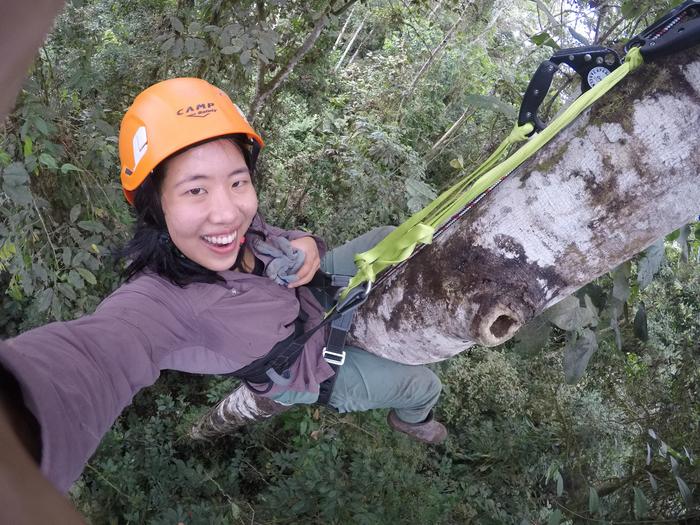With an extendable pole fitted with a small camera, Alison Ke could get a clear view of the inside of a nest box, including one time when a small, green Pacific parrotlet laid eggs. Ke, who earned a Ph.D. in ecology from UC Davis, led a research project to find out how converting rainforest to farmland affects the habitat of birds who rely on tree holes, or cavities, for nesting.

Credit: Courtesy Alison Ke, UC Davis
With an extendable pole fitted with a small camera, Alison Ke could get a clear view of the inside of a nest box, including one time when a small, green Pacific parrotlet laid eggs. Ke, who earned a Ph.D. in ecology from UC Davis, led a research project to find out how converting rainforest to farmland affects the habitat of birds who rely on tree holes, or cavities, for nesting.
Ke worked closely with local scientists and community members to study birds around the Mache-Chindul Ecological Reserve, an area in northwest Ecuador that has experienced rapid deforestation and agricultural expansion in the past 50 years. Their study, published in the scientific journal Biotropica, found that nesting habitat seems to limit reproduction by cavity-nesting bird populations in tropical agriculture, but not in the forest.
“When humans cut down forests for farming, it destroys their nesting habitat,” Ke said. “There are some species that might just disappear if we cut down the forest. It’s extremely important to study the effects of agriculture on wildlife.”
Nest box discoveries
Ke worked with researchers at the Ecuadorian NGO, Fundación para la Conservación de los Andes Tropicales, to conduct bird surveys and observe natural tree holes that were available in both forest and agricultural land. The team also built and mounted 100 nest boxes – half in the forest and half in pastures. The nest boxes were monitored weekly from September 2019 to June 2022, resulting in nearly 11,000 visits.
“We’d stick the camera in, and we’d never know what to expect,” Ke said. “Every time it was something new; it was very exciting. And when eggs appeared but we didn’t know what species it was, it was a like a mystery we got to solve.”
The paper also indicates that cavity-nesting birds were found more frequently using nest boxes in tropical pastures than forests, suggesting that while they visit the farmland, they often lack the nesting resources needed to reproduce there.
Daniel Karp, associate professor in the Department of Wildlife, Fish and Conservation Biology at UC Davis and senior author of the paper, said another key finding from this project is the importance of leaving scattered trees and adding nest boxes to tropical agricultural lands. These actions would not only provide critical nesting habitat for birds but could also help farmers.
“Our work shows that pastures often eliminate critical nesting habitat for tropical birds,” Karp said. “However, by retaining trees in pastures and installing nest boxes, ranchers can provide crucial nesting sites for cavity-nesting birds, many of which might even benefit the farmers themselves by eating pest insects.”
Eight cavity-nesting bird species were more abundant in agriculture, which included the house wren, dusky-capped flycatcher, and the Pacific parrotlet. The collared aracari— a kind of toucan— was the only cavity-nesting species that was more abundant in the forest, which Ke said is likely due to the food available there.
Connecting with the community
After working on this project in Ecuador, Ke created a visual fact sheet that presented details of the study, key findings, and instructions on how to build a nest box. She distributed a Spanish version to surrounding communities and local schools. Ke also produced “Tiny House: Bird Edition,” an informational video about the research project.
Back in California, Ke also served as a field leader for the Davis Nestbox Network, which provides nesting habitat in parks and open spaces in the city of Davis.
Researchers from Tulane University also contributed to this study, which was funded by a grant from the National Science Foundation’s Graduate Research Fellowship program, an academic senate grant from UC Davis, and the ARCS Foundation.
Journal
Biotropica
DOI
10.1111/btp.13252
Article Title
Cavity-nesting birds are limited by nesting habitat in Neotropical agricultural landscapes
Article Publication Date
23-Aug-2023




